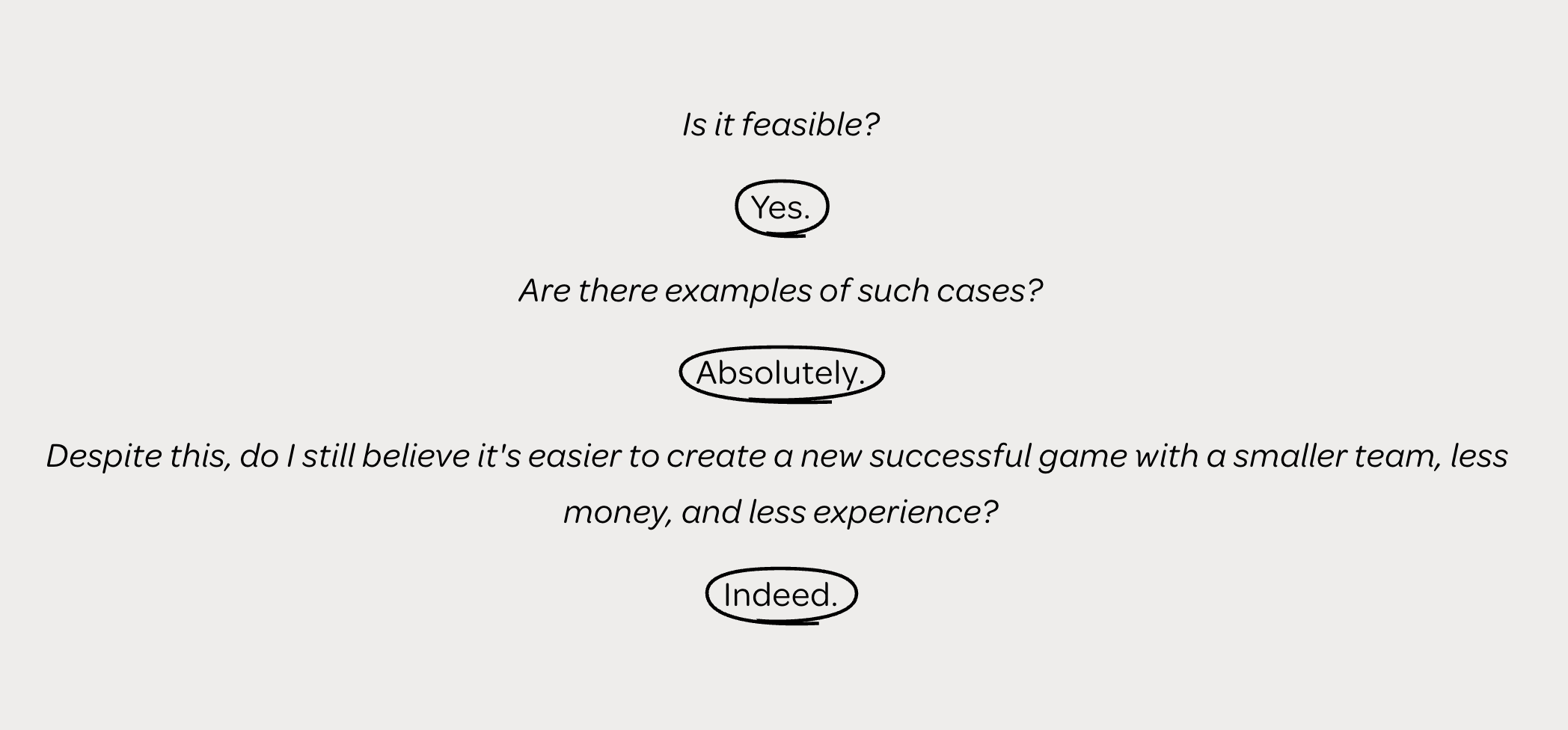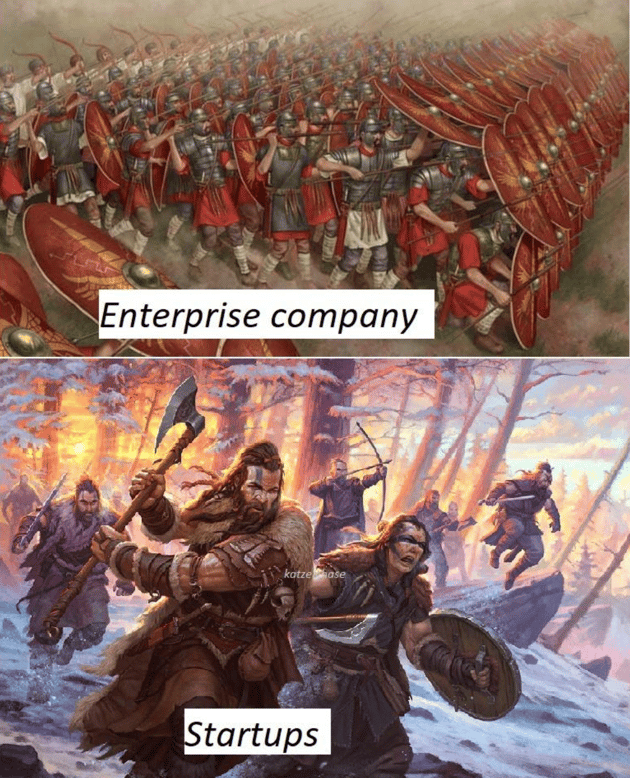.webp)
Six challenges large companies face when making new mobile games

Nikita Tolokonnikov •
In this guest post, Nikita Tolokonnikov, product director at Tripledot, shares his thoughts on why large companies are struggling to make new games, and how these challenges can be overcome.
Disclaimer: Let me be crystal clear, this article isn't about the development approach at Tripledot Studios, where I'm currently brewing a new game. Instead, this is a speculative exploration of the industry's general state, informed by a variety of opinions from industry insiders.
So, what are we doing here? Making games, right?
And the crux of game-making? If we're not running a non-profit, it's about creating successful, ROI-positive games.
But how do we design a game that's destined for success and fosters business growth?
Peering at the market, it seems like no one has a definitive answer. Consequently, what follows this introduction is essentially philosophical musing on the creation of effective new games.
Creating new games vs. scaling existing games
The mobile market of the last decade has been increasingly polarizing into two camps: those who create new games, and those who operate and scale games, supporting them with live ops.
Both roles are essential. A game with strong initial KPIs is worthless if you can't continually find ways to reduce UA costs as you expand your audience, or if you fail to boost LTV by introducing new, relevant content and creating fresh avenues for player spending.
However, there's no point in contemplating growth if you haven't made a functional product in the first place.
Every thriving company needs to master the two distinct stages of developing a new game and scaling an already-existing one.
There are plenty of companies that have crafted a solid game but failed to scale it. Yet, our current market predominantly features companies that excel in business growth and scaling, with their initial games often being a blend of factors (luck certainly being one of them).
What I'm driving at is that nobody really knows how to make a new game.
There are certain skills that enable you to enhance user experience, and you can speculate about your potential players and try to design a game for them. Or, alternatively, you can create a game for yourself and hope that there's a large enough audience out there to play it.
But fabricating a new game that clicks isn't so much about creating a game as it is about building a product you believe in, launching it on the market, and iterating it with real player data as swiftly and efficiently as possible. So it's all about reaching the market as quickly as you can, armed with a variety of ideas and options, and having the agility to pivot swiftly in the right direction.
The entire purpose of this article is to ponder why it becomes increasingly difficult to create a new successful game within a large, successful company as it expands.

And that's the issue I want to chew over today. Why can't large companies that have tasted success once, twice, or even multiple times in the past seem to create something new and instead end up focusing mainly on expanding older games?
Take a look at Playrix and King, or smaller companies like Social Point, Wooga, SYBO. There are many exceptions to the rule, but all these top-tier companies are united by the same challenge: they've been grappling for years to replicate their past triumphs, regardless of their efforts.

The problem with making new games in big companies
Picture this: creating a new game is akin to rolling a D20 dice. Obviously, luck plays a massive role. Imagine a fledgling company with a small yet brilliant team; they score a hit game if they roll anything between 11 and 20.
Here's my contention: large companies significantly stack the odds against themselves. Each of the issues I'm about to discuss whittles our D20 die down to a D19, D18, D17, and so forth, ultimately landing us with a D10, where 11 is still needed for success.
And that's not necessarily their fault. That's just the way 'it's done'.
Sure, this is a bit of an oversimplification, but let me explain my perspective.
Challenge #1: Expectations & patience
With the expansion of any company, expectations inflate proportionally while patience dwindles. This is particularly true for public companies or those seeking a quick sale.
I've ranked this as the prime issue because I've witnessed numerous games with promising business KPIs get axed, all because of the perceived risk involved in nurturing them over time, investing capital in the team and UA and the opportunity cost of not allocating that team elsewhere.
Considering the current market, I dare say it's nearly impossible to create a game that scales smoothly from Day 1 with hefty marketing investments unless you're banking on a powerful IP like Monopoly Go.
In any other scenario, it's a laborious journey spanning months or even years to see the growth that could satisfy a larger company. Consequently, many new games are prematurely terminated as they don't seem immediately relevant to the company's current revenue levels.
While this approach may be justifiable from a business standpoint, it essentially renders launching any new game virtually impossible. Thus, larger companies end up relying on M&A for growth, as well as expanding their existing successful titles.

Challenge #2: Startup culture vs. corporate culture
As a company balloons, it tends to draw in a different breed of people. Don't get me wrong, seasoned professionals are fantastic to work with and genuinely care about their output, but there are a few disparities.
Hiring for a startup, you snag the best 5-10 individuals you can, who are also the most adaptable and, passionate, deeply invested in the game's success.
When recruiting for a company housing thousands of employees, you attract folks who prioritize stability, concentrate on honing their skills, and aren't as committed to the success of a specific project. They sometimes won't even bother with playing games from competitors, deeming it irrelevant to their immediate tasks.
The mindset shift is enormous: the do-or-die survival of a startup, where it's all or nothing, versus the prospect of a marginal increase in recognition if your product succeeds in a large company, perhaps with a minor bonus.
Another distinction lies in developing a game everyone truly believes in versus merely creating a game that seems like the best idea at the moment, a common occurrence in larger corporations. It typically boils down to what's considered a safe bet, usually something derived from existing successful games.
Challenge #3: Hiring for the team vs. hiring for the department
When you're assembling a small, independent team, you're scouting for the best people who will gel with your team. You're considering their cultural fit, their approach, their organizational expectations, their interests as gamers, and of course, their skills. You're fine-tuning everything for optimal efficiency, all for the success of a singular game and a singular team.
However, most larger corporations tend to hire based on general criteria that don't necessarily tie in with a specific project. They recruit what is deemed beneficial for the department, which particularly applies to developers and artists.
In essence, you're optimizing for the company's tool usage, the ability to shuffle people between projects, and the construction of a unified system that offers career paths and opportunities. However, you could potentially be compromising the output of each individual within this specific team.
Challenge #4: Comfort zone
While corporations anticipate massive results from each individual project to impact their bottom line, they also tend to be quite content with their current position. If a giant studio doesn't produce a new game, they're not really losing anything. At this point, they already have a firm grip on the market.
Of course, not every large company is in this comfortable position. However, the success of each individual game is often not a matter of survival. And when survival isn't on the line, you would naturally prioritize and concentrate on expanding your existing products that are already raking in money.
In the end, new games often grapple with a scarcity of resources and priority within the company's grand scheme and are left on the sidelines to either succeed or fail.

Challenge #5: Optimizing for standardization and reusability
Similar to hiring criteria, the objectives for each individual department evolve over time. When you start recruiting a variety of leadership roles to steer departments and strategize for hundreds of developers and artists, you inevitably begin optimizing for standardization and reusability and build technology platforms and tools that can be utilized by other teams.
However, in my personal opinion, while certain tools are indispensable, such as those for managing configuration, AB testing, analytics, and others, the general trend of trying to standardize technology and tools across all teams often leads to inefficiencies. It results in people grappling with tools that hinder them more than help.
It's rare that I've seen a situation where working with another department offering services to all teams ended up being quicker than developing it from scratch within the team. Intra-department teams always have to juggle priorities among many games and optimize for future reusability rather than the individual needs of one person or even the entire team.
All of this hampers your speed and prolongs the time to market, all for a future that may never materialize.
Challenge #6: Over-reliance on production quality
The final hurdle that might complicate the successful release of a game is the propensity of large companies to lean heavily on product quality rather than the novelty of an idea.
In an executive meeting, it rings better if you declare, "We're going to take this successful product, elevate it, and optimize the daylights out of it," rather than presenting a wholly original idea to folks who may not grasp game design. And when faced with the inevitable question, "What other successful games are there like this?" your response is, "None yet."
This always implies that either it can't be successful or nobody has managed to execute it correctly. If you're the first to get it right, that's your ticket to the big leagues.
However, instead, we witness a slew of games that aspire to create a "better version" of what's already out there, but seldom do.
Although it may appear less risky and more appealing in presentations, it is NEVER a safe bet to mimic another game, betting on minor modifications and superior production quality. First off, there's no guarantee you can actually nail it, and second, most players don't really care about production value.
Four ideas for fostering an environment of innovation
So, what's my point? Once your company expands beyond a certain threshold, there are several approaches to developing new games to boost the potential success rate.
And it's not just about creating new teams within your company.
My first proposal might sound overly radical, but otherwise, it would be a snooze-fest, wouldn't it?
Option #1 - Form a subsidiary company
When you're aiming to create a new game, form a subsidiary company for it with its own structure and its own founders whom you've handpicked specifically to develop that one game and who are experts or possess a deep passion for this particular game.
This company will have its own structure, tools, P&L, goals, and expectations. If the game doesn't pan out, then your evaluation should differ from that of a project within your company. Do they still have a promising idea that they're passionate about, aligning with their expertise? If so, it's worth another shot.
And if they don't? Instead of dispersing people among other teams or brainstorming what the best option for the next game might be like, it's typically done in these scenarios, dissolve the company and let the people go.
I know it sounds severe, but it makes sense from a business perspective. That's the Netflix philosophy: enlist the best people for a specific job, and if that job no longer exists, it doesn't make sense to keep these people on board for the sake of continuity, does it? It's not ideal for the company nor for them.
Option #2 - Work with external development teams
Other less-extreme but evident methods include hiring existing external development teams to make those games, which is less risky and simpler. This enables you to find the best team suited for the game you want to make and doesn't bind you to hiring people and then wondering what to do with them if the game doesn't work out.
Option #3 - Invest in other companies
Personally, I love how Supercell handles it (of course, besides the fact that they have a lot of internal teams working on new games) - they invest in other new companies. This approach enables them to place many more bets and get super-motivated small external teams to create their dream game in the most efficient manner. Like in the case of Everdale, Supercell understood that it wasn't the type of game that could be developed in the way it needed internally and actually handed it off to Metacore, one of their investees.
Option #4 - Straight-up M&A
Lastly, there's M&A, a strategy everyone already uses. However, at the moment, everyone with funds is perpetually on the hunt for promising new games, often sparking a bidding war with companies shelling out exorbitant sums for the chance at potential success.
There’s definitely more here to ponder than one short article can cover. But it’s a start.
In the meantime, I'll be diving back into creating a new game, and I wish all teams out there, both small and large, to keep pursuing what they believe in and push forward with all their might.
Who knows, you might be the next to hit the jackpot.



